8 Tips for a Zero Waste Wardrobe
My wardrobe wasn’t the first place I thought of when I went plastic-free and zero waste. No, the first place was the kitchen, and the second place was the bathroom. After all, these are the places where we generate a lot of packaging, because many of the things we buy are consumables (meaning, we use them up and they need replacing).
But once I’d been on the zero waste journey for a while I started to think about clothing. I’m the kind of person who wears things well past their life expiration date – things will have holes and be almost threadbare before I’m ready to part with them.
At this point, clearly they aren’t fit for the charity shop.
It was then that I realised that many of these fibres in my wardrobe were synthetic, not compostable and not really recyclable.
- Textile recycling is limited in availability (meaning recovery rates are low – in the USA recovery rates are estimated to be 15%);
- Textile recycling is also limited in effectiveness and is generally not closed-loop: many textiles are recycled “thermally” (meaning incinerated for energy) or using chemicals;
- Let’s not forget the sheer volume of textile waste created every day. (It’s estimated that Australians discard 6,000kg of fashion and textile waste every 10 minutes. That’s just the waste in one country…)
Figures like this can be a little depressing, and I don’t like to focus on the problems. I much prefer solutions! Over the years I’ve been working on making my wardrobe as zero waste as possible, and I want to share what I’ve learned.
There’s a lot to say. I’m going to start with what choices I make when I let things into my home to ensure they get the best use and last well, and how I plan for zero waste with the purchases I make.
Next week I’ll share how I let go of things I no longer need, or things that have life expired, without chucking them in the bin.
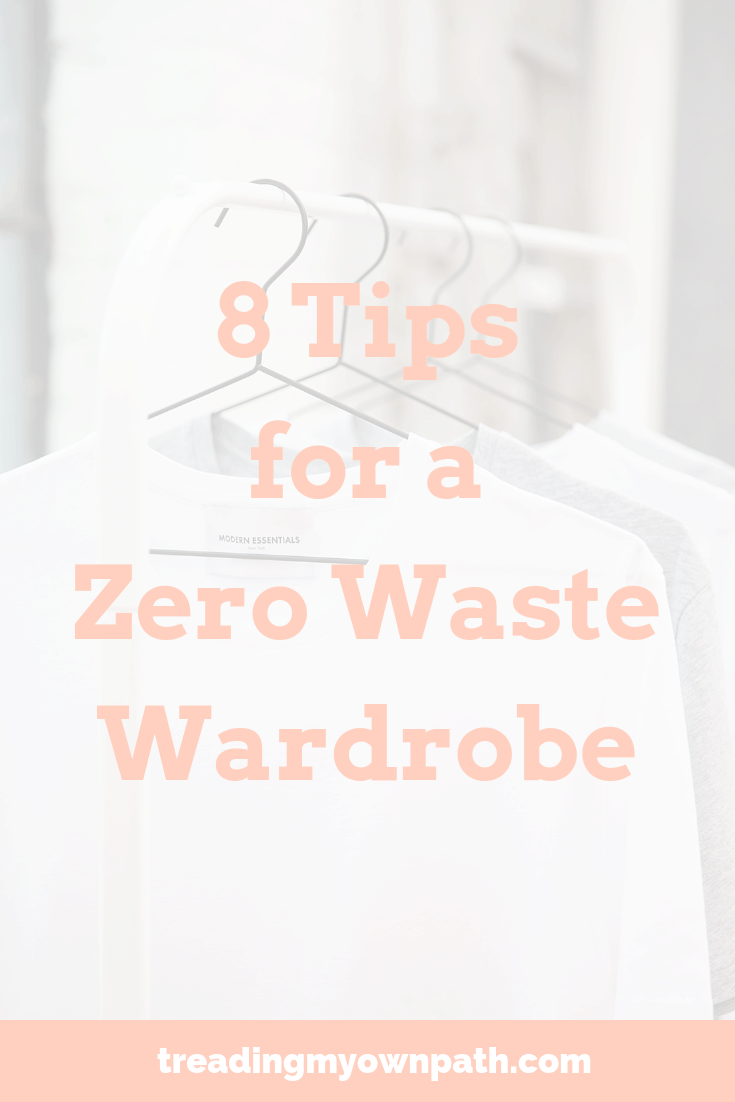
1. Buy Stuff You Will Actually Wear
This sounds so obvious, but I have definitely been guilty in the past of buying clothes that then just sat in the wardrobe, tags still attached, unworn.
There were a few reasons for this:
- Choosing items that were a little too tight, or that looked good but weren’t actually comfortable;
- Choosing an item that I loved the look of in the shop (or on the model) but that didn’t actually suit me;
- Choosing something that wasn’t the kind of thing I actually had an occasion to wear (I might love the idea of dresses in reality, I love to wear jeans more than anything else);
- Not being practical about whether the item I bought matched the things I already owned.
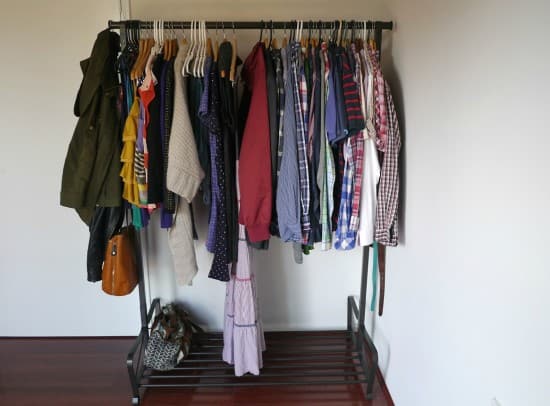
It was only after I decluttered my wardrobe down to my essentials that I really began to understand exactly what I wore – the colours, the styles and the materials. Now I’m much more strict when I chose things.
If it’s not a definite yes then it is a no. There’s no room in my wardrobe for maybe.
2. Don’t Be Tempted by “Bargains”
I’ve purchased many “bargains” in my time that have sat in my wardrobe, unworn (usually for the reasons mentioned above). I used to have a real weakness for labels telling me the item was 70% off.
However, I can get an even greater bargain, and save 100% of my money, by not buying things that I then never wear.
When I first started shopping for clothing second-hand, the same thing happened. There were so many great items that were so cheap! Rather than thinking – Do I need it? Will I wear it? Is it worth it? – I’d think, wow, what a bargain!
Cue more things I didn’t wear.
A bargain is only a bargain if it is something that we will wear, and often. Now I ask myself, would I buy this if it was full price? Meaning, do I love it that much? I need to love the item more than the price tag for it to be worth bringing it home.
3. Choose Clothing You Can Wear 30 Times
Yes, it is better to only buy clothing that we love, that fits, that suits us and is practical for our lifestyle. If we want a zero waste wardrobe, we also need to think about how well made things are.
Buying something we love only to find that after 3 washes, it is bobbled and misshapen to the point of being unwearable is disappointing, frustrating, and a waste of resources (the materials it is made from, the effort that someone put into making it, and the work we’ve done to to pay for the item and bring it home).
Whenever I’m thinking about whether to buy an item, I ask myself two questions:
- Will I wear it 30 times?
- Can I wear it 30 times? (Will it last?)
If I can’t honestly answer yes to both of these questions, then I don’t make the purchase.
(Of course, things don’t always go the way we intend. We can mean to wear an item, and then change our minds later. But the more honest we are with ourselves the less likely we are to buy things we think we like, but don’t. If an item disintegrates after 5 washes, we can learn from this and be more mindful about choosing that material or brand next time.)
4. Avoid Excessive Embellishments
Beads, sequins and tassles might look fantastic on a brand new item, but they make an item much more difficult to wash (often meaning handwash or dry clean only) and they tend to fall off quickly.
If we’re not inclined to sew things back on, this can mean a premature end for our clothing. However, most beads, sequins and embellishments come off and are lost (meaning we can’t sew them back on, even if we are inclined to do so). Plus many are plastic, meaning plastic pollution.
I’ve made purchases like this in the past. I had a dress covered entirely in sequins, and whilst I loved that dress, it didn’t make it to 30 wears.
I still have a jumper sewn with tiny black beads that I’ve owned since 2011, that has lasted more than 30 wears. I’ll snip all the beads off before I compost the jumper, but it’s not something I’d purchase again.
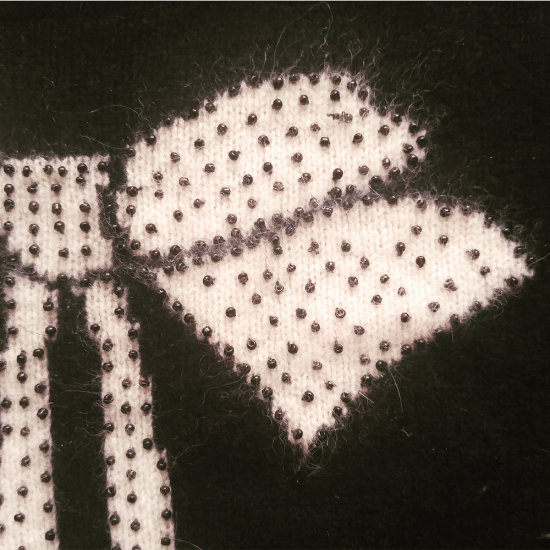
However pretty sequins or beads are, now I choose not to buy these things. That way I don’t have to worry about where they will end up. I want clothing that will last, and I don’t want my clothing contributing to plastic pollution.
5. Shop Second Hand
I’m often torn between wanting to shop second-hand and wanting to support ethical, Fair Trade clothing companies by purchasing their (new) products.
With only 15% of all clothing donated to charity shops actually re-sold (the rest is dumped overseas, processed into rags or landfilled), I tend to lean more towards the second-hand option.
Buying second-hand means less new resources used, and less items heading for landfill. I shop at a couple of charity shops that I know sell good quality items and don’t have an overwhelming amount of choice. If I’m looking for something specific I use eBay.
6. Choose Natural Fibres (Where Possible)
I would love my wardrobe to be entirely natural materials, but let’s just say that is a work in progress. I’m very conscious of the materials I buy, and I always check the label before making a purchase.
It can be hard to find natural fibres in charity shops or second-hand.

I’ve had some great successes, for example this skirt (cotton and elastane, percentages unknown), denim shirt (97.8% cotton) and silk top (100% silk) were all second-hand from the charity shop.
Recently I needed some shirts for my talks/workshops, and I had to settle for two polyester numbers. I can tell the difference when I wear them immediately (I feel like I’m wearing a plastic bag), and I’m planning to re-donate them to the charity shop once I can find a natural fibre replacement.
7. Choose Recycled Synthetics (If Natural Fibres Aren’t An Option)
Whilst I try to limit my use of synthetic fibres as much as I can, sometimes it is unavoidable. When I headed off on my camino adventure, I purchased a rain jacket. I’ve really needed one for years, but the trip pushed me over the line.
The raincoat I purchased was made by Patagonia, who are well known for and committed to pursuing sustainable practices. The outer is made from 100% recycled nylon.
8. Shop Ethical
When I need to make a new purchase, I try to support ethical, sustainable brands. I don’t buy many clothes brand new, but it does happen.
One thing I always buy new is underwear. There are two brands I buy, Etiko and Mighty Good Undie: both are Fair Trade and use organic cotton. I don’t have a preference, but usually one brand is out of stock when I go to order so I go with whichever has my size.
Etiko is slightly cheaper but also slightly lesser quality, and the sizes also come up slightly bigger than Mighty Good.
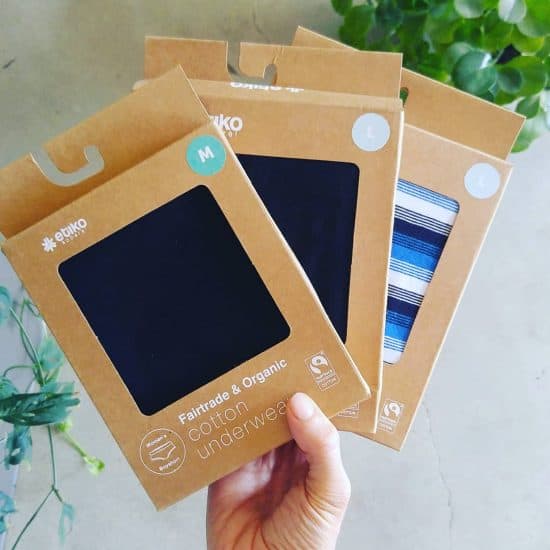
Yes, both brands are more expensive than regular non-organic big box store brands. After I have a minor heart murmur over the price, I remember that I don’t buy new underwear often (maybe once a year) and I don’t buy new things often, and when I do make purchases, I want to act in line with my values.
That means supporting small business, supporting organic farming, and supporting Fair Trade practices.
To me, that’s worth the extra few dollars. In reality the difference is less than the price of a glass of wine or smashed avo on toast, and supporting a better world is worth prioritizing.
…
I don’t purchase everything second-hand, nor do I purchase 100% organic, Fair Trade and natural fibres. My ideal would to be able to find everything that fitted all of these criteria (except perhaps for second-hand underwear!) but the reality is, there’s often compromise.
My goal is to do the best I can with the options available to me and the resources I have; to learn as I go, and strive to do that little bit better next time around.
Now I’d love to hear from you! How do you reduce your eco footprint when it comes to your wardrobe? Do you love second hand stores, or do you prefer new ethical fashion? Is there anything you particularly struggle with? Any tips to add? Please share your thoughts in the comments below!
[leadpages_leadbox leadbox_id=1429a0746639c5] [/leadpages_leadbox]


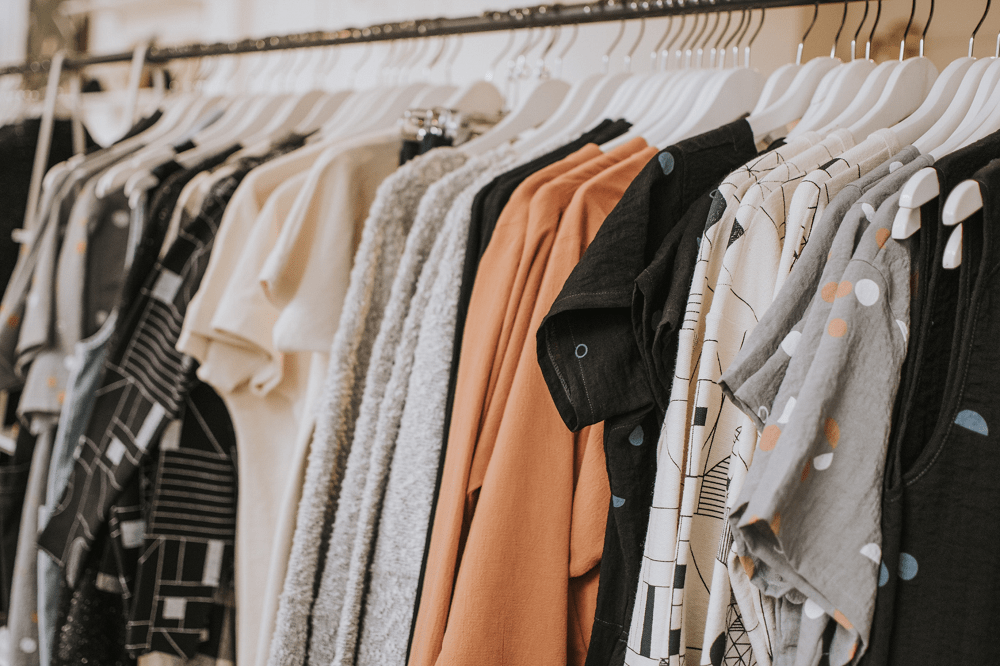





Thank you for sharing your tips with us. I’m in Perth too and it’s such a help having local suggestions – do you mind sharing which 2nd hand clothing shops you’ve found to be good re quality and range. Thank you again – it’s always lovely to see a new post from you!
Hi Heather! My pleasure. I particularly like the Vinnies in Applecross/Ardross on the corner of Canning Highway, and the RSPCA shop on High St, Fremantle (right near the Raw Kitchen – it’s branded Reloved). There’s another Reloved RSPCA shop in Northbridge, and I’ve heard there’s lots of good charity shops in Mount Hawthorn although I rarely go that way. Hope that helps!
I buy underwear from Merino Country. All except the elastic is wool and it’s made in Australia. My husband loves his version.
Cloth and Co are an ethical online brand for cotton dresses and lounge pants. So comfy.
It’s a total bonanza when I buy natural fibres second hand. Hopefully there’ll be more in the future.
I purchased a sports bra that was merino when I went on the Camino, Ann. I had no idea such things even existed! Totally beats my 100% plastic previous sports bra. Hurrah! :)
Yes natural fibres second hand is the jackpot!
thanks for sharing your tips – like you I started with the kitchen, then the bathroom (these are still working progress – especially the bathroom). I have also been thinking about clothes and underwear. There’s a European vote regarding plastic coming up in the next few weeks, so fingers crossed something big happens !
Hi Linda, yes clothing isn’t the first thing most people think about and certainly not the easiest – but it is such an interesting journey, and so many paths to take and so many solutions! I love hearing how different people have made their own wardrobes more sustainable – so much to learn!
Yes, that will be interesting to hear!
Avoiding anything that needs hand-washing, and especially dry cleaning. I had a coat that I loved that I didn’t wear for two or so years because it needed dry-cleaning. I recently got it dry cleaned but have sent it to an op shop because I’ve learned that I’m sure not going to get it cleaned again if I keep it – the extra effort and expense is more than I’m willing to put in. Not to mention how environmentally unfriendly dry cleaning is!
It’s similar with hand-washing too. Call me lazy, but I’m not going to go out of my way to clean one item of clothing every time I wear it. And from a water saving perspective, I doubt it’s as economical to handwash something if you could chuck it in the washing machine with everything else.
I also try to remind myself that renting special occasion clothing is possible too.
Hey mindfulovermatter,
I also check very carefully how my clothing/textile products need to be washed or cleaned. But I also learned that many things that are labeled as “no washing machine” or “hand-wash” can actually be washed at 30°C with a low spin number. To be extra careful I don’t hang them for drying but rather dry them in horizontal position. It has worked amongst others for ball robes, fake leather coats, felt coats and cotton chair cushions which all said not to wash them in the machine. Maybe you could give this a try. :)
Wool should not be washed, even hand washed, after every wear. Aired out between wears and you can wash it once or twice a season. One of the most environmentally friendly options.
I have a rule (I think I read it somewhere, but maybe I just made it up in my head!) that you can always go one down from the washing instructions. So if it says cold wash, you can wash at 30 degrees. If it says hand wash, it can go in the machine on cold or on the machine hand wash setting. If it says dry clean, it’s fine to hand wash! Of course it depends on fabric – some aren’t suitable for getting wet! – but that’s the rule I follow. Avoiding stuff like sequins makes things more suitable for the machine.
I did the same with my actual dry cleaning / hand wash stuff that really did need to be dry cleaned – cleaned it up, then donated. I am lazy too! And I agree with you with ALL your reasons!
(Same applies for anything that needs ironing. I hang stuff upside down to dry – if that doesn’t get the creases out and it truly needs ironing, it isn’t staying in my house because I will never iron it.)
https://www.bamboobody.com.au
Ethically produced bamboo clothing, great Australian company. Bamboo cloth actually draws moisture off the body in a capillary action, keeping you cool and dry (great for Queensland summers). The underwear is very comfortable and moulds to you shape. Lasts years so I don’t mind the expense. I buy via mail order and it arrives wrapped in brown paper.
Thanks for sharing Leigh. I’m really not sure about bamboo fabric, I read a great article on the Biome website about why it isn’t eco friendly (the chemicals and processing and murky practices). It’s something I’m keen to learn more about. People say they love to wear it though, and comfort is so important – we just don’t wear clothes we own if they aren’t comfortable!
Thanks Lindsay- great post. The Shopportunity knocks shopping tour was great for sampling consignment and charity shops- I would highly recommend it! Also any conclusions about Bra’s??? any info welcome.
I’ve buy cotton Fruit of the Loom bras. When they are done I cut off the elastic and the cotton goes to a charity that collects cotton (they get money from a company that makes insulation).
Hi Pauline, have you heard of Uplift? They recycle bras in Australia and also repurpose the clasp bits. Check them out :)
I love your blog and pick up lots of good tips, thank you I buy and/or acquire only second hand clothes. I was a little tempted for the first time in years by the new William Morris print designs at H & M but – nah – all synthetic materials…. I also try to seek out natural fibres so I can put them on my compost heap afterwards.
I took part in Plastic Free July this year as I did also the past few years and was inspired to make this song, have a listen if you fancy :) it’s called Plastic Sand https://suedenim.bandcamp.com/
Lots of love
Hi Sue, I find that synthetics fibres often put me off any temptation for these things! And thank you for your kind words regarding my blog!
Thanks for sharing the link, I’ll have a listen ;)
Thankfully, I have a charity that collects all cotton (ripped or otherwise) and they get money for it. From what I understand they use it for insulation.
I also have a question, I recently purchased underwear (in Canada) that claimed to be ecologically friendly because it was made of bamboo. When I looked at what it was made of it says Rayon. Is Rayon fabric what comes from Bamboo? This to me still would be synthetic. Thoughts on rayon.
Did some research. It seems that the process in which they make rayon is not safe for workers but the fabric is biodegradable. It’s considered a semi-synthetic though.
That’s cool Heather, I like the idea of cotton insulation (rather than plastic). As for the bamboo/rayon issue, I really need to write a blog post about all these different fibres and whether they are eco-friendly! One to add to the list!
I sew my own from natural fabric (and cotton thread, often even natural fabric clothing is sewn together with polyester). That slows me down, and ensures stuff fits, is my style, etc. and avoids impulse purchase.s Haven’t gotten as far as fair trade fabric, though, and I do still use some elastic in my sewing (I’m not making undies without elastic!)
And my homemade bras are still all made from nylon/polyester etc. It’s almost impossible to find fabric with the right amount of stretch/rebound for them. I haven’t been brave enough to go to vintage styles, which were made of non-stretch. Maybe one day.
That is so great and inspirational, Mim! Learning how to sew has been on my to-do list since forever, and I will get there one day. I love this – and yes, polyester thread is almost unavoidable, even in fabric that is labelled 100% cotton – seems the thread doesn’t count!
The bra conundrum – a whole other topic of discussion, it seems!
I just came across this article on the hunt for cotton thread and can confirm- There are no more suppliers (to Aus at least) of cotton overlocking thread except in single use plastic spools.
If anyone knows of any pleeeease add it below! <3
I make clothing out of recycled cotton towels and would love to get my little brand down to zero waste xx
Unfortunately I can’t buy second hand because of the detergents and fabric softener that are made with petroleum products. I have an allergy to anything made with petroleum products. So, I can only wear natural fibres. Synthetic and natural fibre blends pill very quickly . Natural fibres resist stains and are generally stronger. I have many things that are decades old, natural fibres .
Thanks for sharing Lynne – I hadn’t even considered the detergents etc. Your wardrobe must be so carefully curated and sounds amazing!
Thanks for this blog, also keen to hear more about bras, will check out Fruit of Loom. Likewise my wardrobe and kids’ is mix of 2nd hand mostly from local op shops, hand me downs from older cousins (Love this) and new undies, tights etc natural organic when possible.
We have 2 great setups here in Far North of NZ where people can drop off still wearable clothing and take anything they want for themselves at no cost, one at local gym and another at fantastic Bush Fairy Dairy. We are also doing our first clothes swap meet this month, gold coin entry at Eco Centre with anything left going to Women’s Refuge if participants choose.”
And wanted to add – borrowing friends clothes has been particular useful this year in 2 once in a lifetime events – escorting NZ Governor General Patsy Reddy and meeting royalty, Duchess of Sussex, Meghan Markle – certainly alot easier on the wallet, as well as the environment!!
Thanks for sharing Waikarere – yes, borrowing clothes is great! I’ve borrowed dresses for a couple of fancy dinners and also a wedding – saves me buying these -wear-it-once type of outfits, and means they get more use, cos I don’t think my friends are wearing them that often either! ;)
Clothes swaps are great – you will have to tell me how it goes!
And I will have to do some research on bras! :)
Thank you so much for sharing. It is certainly something that plays on my mind, particularly as we are essentially wearing plastic a lot of the time. I have put myself on a clothes shopping ban this year so I can fully appreciate the value of what I already own. It is a tricky one because the fashion industry have us well trained into constantly keeping up and consuming.
I recently had a co-worker comment on me wearing the same dress 2 days in a row (we work sitting down in an air conditioned office all day). I pointed that fact out to him and made a point of saying that it is the advertising companies and fashion industry that have taught us that this is wrong. 100 years ago the average person would not have owned the volume of clothes we do now.
It is such a massive issue to tackle, but individual actions certainly do add up.
Oooh, a clothes shopping ban Kerry? I love it! I hope it is going well (feel free to share details!)
I’m surprised that your colleague noticed! I’ve worn things a couple of days in a row when I worked in an office to test if people noticed, and nobody said anything – I assume they didn’t notice. Most people don’t. Funny that he did! But anyways, who cares?!
It is a massive issue, but one with lots of opportunity for positive change :)
Hi Lindsey
Lovely article on clothes. We do buy and hold on to too much. I’ve been doing a lot of drawer and wardrobe clearing lately and have to agree with you re purchases.
I’ve become quite ruthless in sending piles of ‘I might wear one day’ items to the op shop via a friend who has clients in need (usually they can’t afford new clothes, often also mobility impaired).
Also, sort of along this theme, is knitting. I recently knitted a lovely shawl/scarf for one of my daughters. I chose carefully, wanted Australian Merino, was surprised, on reading the labels, that often it was spun in a foreign country. Took me ages to find exactly what I wanted. 100% Australian wool, 100% produced in Australia. I like using Bendigo Woolen Mills as,for me, that’s not only 100% Australian, but local. People often use synthetic yarns because they are cheap or because they have a ‘good’ label. There is however plenty of inexpensive ‘real’ wool available if one looks around, even on gumtree.
Cheers
Ann
Thanks Ann, and yes we do! Much better to donate those “might wear it sometime maybe” items.
One day I plan to be a knitter and person who sews (!) but there’s so much to learn – not just the techniques but all the sourcing of materials etc. For now I enjoy following along people who are way ahead of me on the journey :)
I can relate to all of this. I am now down to all natural fibres in my wardrobe but it did take a bit of searching when I needed to replace clothes. My wardrobe has also shrunk down to what I wear in each season or in-between seasons. Old clothes have been cut up for rags and strips to tie up vegetables in the garden. The ABC programme ‘War on Waste’ was very sobering. Mind you this particular journey has taken about 4 years, so not an overnight thing by any means.
Hi Virginia, oooh agreed about the timeframe! Slow fashion indeed. (Not that I make any claims to be fashionable. But you know what I mean.) I purchased my two polyester tops because I urgently needed something for a bunch of talks – I’d forgotten what it was like to wear 100% polyester (= yuck). I won’t do that again. A very good reminder!
Old clothes that are past their best and not good enough to donate to the op shop either go in the gardening/decorating pile – to be covered in paint etc. or are cut up for rags for cleaning. Old t-shirts (or even pants!) are great for cleaning or DIY jobs as they do not scratch surfaces or shed fibres. I have fond memories (not!) of dusting the house with my Dad’s and brother’s old Y-fronts!
This is what I’m talking about next week Caroline – the other part of zero waste wardrobing… what to do with stuff that’s worn out! And yes, rags are a feature! It blows my mind that people go out and pay money for rags. Everyone who wears clothes ends up with rags, why would we buy them?!
I’ll admit, I’m in a stage of zero waste where I think I know it all. So the ’embellishment’ point pulled me up. Partly cause I LOVE an embellished epaulettes! Both tops that come to mind, with that, are both bought second hand! So win some, lose some! I do get your point though.
I’ve decided to swear off ‘new’ polyester. I will only buy a polyester top in a second hand store, never new. And I admittedly buy much synthetic for work out gear – which is seldom my size and style in second hand stores (and so little quantities of work out clothing is donated).
That’s funny Sarah! Yeah, second-hand can be a grey area for things like that. I’ve found some second-hand workout stuff in a charity shop close to me, which always has good quality items. But I really dislike polyester! I may have to look into natural fibre exercise clothing at some stage…
I’m all about a zero waste wardrobe, and my friends actually make jokes about how I wear the same 5 things all the time. I quite literally wear them until I can’t wear them anymore, like they have holes or rips in them.
Why aren’t more people doing this? It’s distressing to me.
It is distressing to me, also! I take things a little too far down the “worn” path, but I like to get good use out of everything. It blows my mind that people ditch outfits because they have been in more than three pictures on Instagram. I didn’t even think it was a real thing until I met someone whose friends did that…
Thanks for as usual usefull and inspiring tips Lindsay! Bras and undies is such a struggle eh. The rest is a lot easier. I’m totally in for the second hand clothing, and in fact i have few second hand items that i got for free (!) in a charity shop in israel few years ago and i still love them) i also dont part with favourite items easily, for instance i have a lovely skirt i got in an outlet somewhat 10 years ago, and i still wear it! Its cotton, if i remember correctly (all the tags came off by now, naturally)) Whenever i have a photo of me wearing the skirt taken, i think for a brief moment, oh shoot what if people recognise it (its rather distinct floral print skirt) from years ago, will they think I’m so broke i cant afford a new skirt?!.. But then, who cares) avoiding impulse buys and items that dont match style/the rest of the wardrobe is a bit tricky, but I’m doing it since i set my mind on careful thought through, sustainable, reasonable, as minimalistic as possible wardrobe. A good way to save money, too!
Great text! I’m just starting a year without new clothes, so I need this kind of inspiration. Thanks!
It is so inspiring to hear all your comments…I’d like to add something as a conundrum — I have a broken right shoulder (not operable) which is called rotator cuff syndrome. My left shoulder is now also “fading” so because of these problems, I have to wear front-closure bras, which are expensive and hard to get here in Germany to the point that I sometimes order from a store in the US. None of the materials used are really recyclable that I know of: nylon, polyester lace, elastic. So far, I have not found any in a cotton fabric.
Best wishes,
Jean Kroeber
Germany
Thanks for another informative post Lindsay. For people looking for a zero waste, ethical bras, an Australian company had a kick starter recently…. https://theverygoodbra.com/. I got two and they were delivered recently. They are very comfortable so I wear them for work (office work 3 days a week) or at home. I’m a size 12E so they don’t work for Parkrun (5km) but have enough support for general daily activities. I was very pleased to find this alternative.
Does anyone know where to find zero waste, 100% natural fibre, ethically made socks? I’m trying to avoid having to knit my own socks…. I don’t have the patience for that! :)
You could try Nundle woollen mill socks in NSW. They have a website and will answer any questions you have.
Thanks everyone for all those tips – perfect timing as have been thinking about making a better choice for underwear so now lots to look up.
I love your website Lindsay! Regarding underwear – have you checked out Thunderpants? Great if you want some unusual designs. Recently I supported a kickstarter project in Australia called The Very Good Bra – zero waste bra made from Tencel. Even sustainably sourced! Totally biodegradable. It was very expensive though at about $100 for matching bra and knickers, perhaps because it was a limited run. Hopefully they will be able to produce this on a larger scale more cheaply.
Have you heard of the app “Good on You”? It helps with choosing which clothing brands are ethical!
Interesting ideas, Lindsay! Hope I can practice these everyday. Started using reusable menstrual products and made my own DIY panties. I think this is a good start.